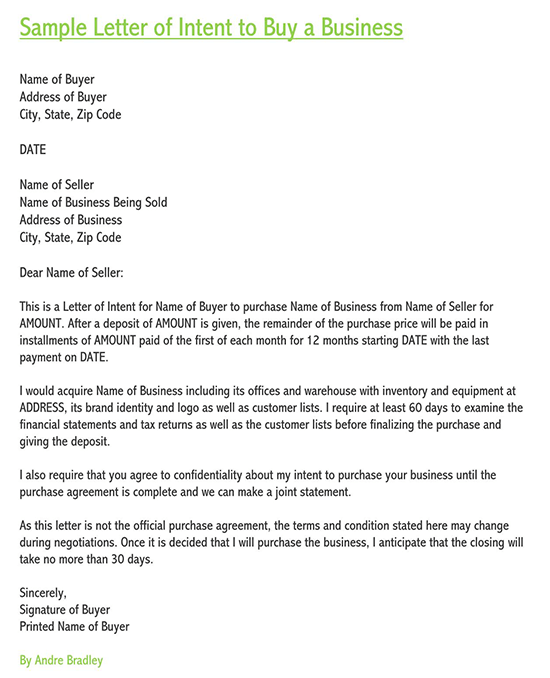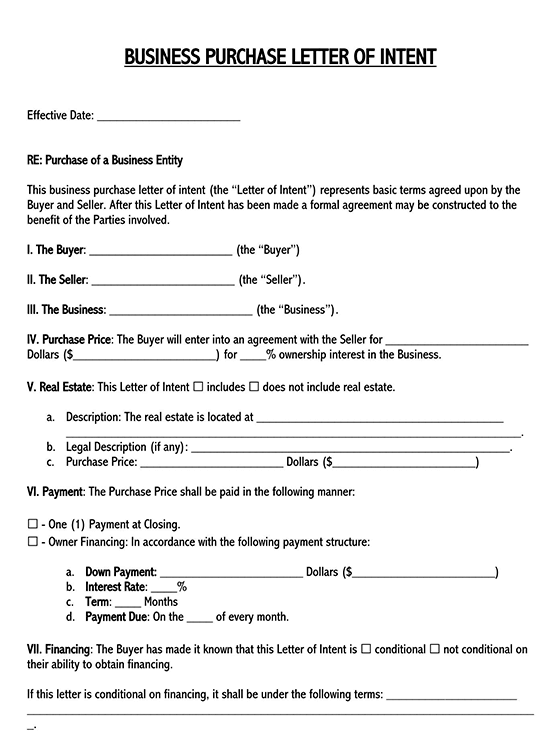Some purchases are too large and risky to be handled anyhow. Any errors, lapses, or inconsistencies that come along may usually attract far-reaching repercussions. You can never approach them anyway. Instead, you have to tread the said paths cautiously to be able to safeguard yourself from any losses.
The business purchase letter of intent comes in to solve this problem. This is a written proposal of the kinds of purchases that the buyer and the seller intend to partake in. The letter creates the basis upon which subsequent purchases are made. It is not legally binding, though, and may hence be side-stepped.
Free Templates


Why is the Business Purchase Letter of Intent Necessary?
This letter is necessary in several ways and for several reasons. Below are some of the ways and means through which its use may bring about benefits to your firm:
Explains the details of the transaction
For a start, this letter breaks down the details of the impending transactions between the buyer and the seller. It shows exactly what the seller is offering to the buyer, at what cost that is going to be, and the terms that the purchase is to abide by for it to succeed.
Prioritizes the specified buyer
Though this letter is not legally binding, it places the specified buyer at an advantage over and above the other potential buyers. Thus, the person entering this agreement has been assured some sense of security. Regardless of what may transpire ahead, the specified person may rest assured of receiving this item first.
Vouches for a buyer’s seriousness
To the seller, this letter acts as a confirmation of the seriousness of the buyer. By the buyer appending his signature to such a crucial agreement, it means that he is ready and willing not only to purchase the commodity but also to partake in any other issues that may come along with implementing the transaction.
Allows for easier scrutiny
As part and parcel of drafting this letter, the buyer has the right to scrutinize the business he intends to transact business with. That is the only guarantee that the agreement he eventually enters will be well-informed and devoid of any grey areas or obstacles. This is advantageous to the potential buyer.
Solidifies the existing bonds
Such a letter also goes a long way in solidifying the bonds that already exist between the buyer and the seller. These bonds may form the bedrock against which future engagements may be crafted and handled. It also creates a nice rapport between this buyer and the seller going forward.
What Should be Included?
Even though the business purchase letter of intent takes many forms and shades depending mainly on where it is crafted, it also contains numerous similarities.
Below are some of the ‘must-have’ contents of a typical letter of this kind:
- Introductory clause: As with many other official letters, this one, too, has an introductory clause. In this clause, the statement of the purpose and intent of the letter is demonstrated. Accompanying this is the precise date when the letter ought to be deemed effective. Lastly, the exact piece of property is also described and explained in finer detail here.
- Parties to the transaction: There are usually only two parties to any transaction. These are the buyer and the seller, respectively. Their identities, as well as the kind of property that is about to change hands, are revealed in detail here.
- Transaction and timing: In this section, the specific kind of transaction is explicitly stated. The time that the aforementioned transaction is scheduled to be formally executed comes next. Given that this letter is not legally binding, the details showcased here are merely provisional and hence subject to change at any given time.
- Contingency measures: Contingency refers to the preconditions that have to be met before the transaction is finally executed.
EXAMPLE
The buyer has to obtain the whole amount first before the real estate property changes hands. It is these measures that will keep the seller well-informed on what to anticipate.
- Due diligence: Before making a large and expensive purchase, it is necessary for the parties to verify the credibility of the purchase process and the items at hand. This is called due diligence, and it entails skimming the various records to vouch for their accuracy and validity. These include documents of ownership, tax records, liabilities, collaterals, ongoing litigation, and indeed, more besides.
Template
[Buyer’s Name/Company Name]
[Buyer’s Address]
[City, State, Zip Code]
[Email Address]
[Phone Number]
[Date]
[Seller’s Name/Company Name]
[Seller’s Address]
[City, State, Zip Code]
Subject: Letter of Intent to Purchase [Business Name/Assets]
Dear [Seller’s Name],
This Letter of Intent (LOI) is to express [Buyer’s Name/Company Name]’s formal interest in purchasing [specific assets, the entire business, or describe the business segment] of [Seller’s Name/Company Name], herein referred to as the “Business”. This letter outlines the preliminary terms and conditions under which [Buyer’s Name/Company Name] proposes to purchase the Business.
1. Purchase Description:
The proposed transaction would involve [describe the assets or share purchase in detail, including any specific exclusions].
2. Purchase Price:
The proposed purchase price for the Business is [amount in words and figures], subject to adjustments as agreed upon after due diligence.
3. Due Diligence:
[Buyer’s Name/Company Name] will conduct a thorough due diligence review of the Business’s financial, legal, and operational status. The due diligence period is expected to last [specify duration, e.g., 60 days] from the date of signing this LOI.
4. Confidentiality:
Both parties agree to keep the terms of this LOI and all related negotiations confidential. A separate confidentiality agreement [is attached/ will be executed].
5. Exclusivity:
[If applicable] [Seller’s Name/Company Name] agrees not to engage in negotiations or discussions with other potential buyers for a period of [specify duration] from the date of this LOI.
6. Terms and Conditions:
Closing Conditions: The completion of the purchase is subject to certain conditions, including but not limited to due diligence satisfaction, financing arrangement, and the execution of a definitive Purchase Agreement.
Purchase Agreement: Both parties agree to negotiate in good faith to execute a definitive Purchase Agreement by [specify target date], which will contain customary representations, warranties, covenants, and conditions.
Governing Law: This LOI and the proposed transaction shall be governed by the laws of [specify jurisdiction].
7. Non-Binding:
This LOI does not constitute a binding contract to purchase the Business, except for the terms relating to confidentiality, exclusivity, and governing law, which shall be binding on both parties.
We believe this proposed purchase represents a mutually beneficial opportunity and look forward to proceeding to a definitive agreement. Please indicate your acceptance of this LOI by signing and returning a copy to us by [specify deadline].
Thank you for considering this proposal. We are excited about the prospect of acquiring [Business Name] and integrating it into our operations, believing strongly in its potential for future growth and success.
Sincerely,
[Signature]
[Printed Name]
[Title]
[Company Name]
Accepted and Agreed:
[Signature of Seller]
[Printed Name of Seller]
[Title, if applicable]
[Date of Signature]
Sample Letter of Intent
Dear Mr. Doe,
Subject: Letter of Intent to Purchase XYZ Widgets Inc.
I am writing on behalf of ABC Enterprises to express our formal interest in purchasing XYZ Widgets Inc. After our preliminary discussions and thorough analysis of XYZ Widgets Inc.’s operations, financials, and market position, we are convinced that this acquisition would be mutually beneficial and align with our strategic growth objectives.
1. Purchase Intent
ABC Enterprises intends to purchase all the assets and operations of XYZ Widgets Inc., including but not limited to all customer lists, patents, trademarks, trade names, equipment, and inventory. We believe that integrating XYZ Widgets Inc. into our operations will enhance our product offerings and market reach.
2. Purchase Price and Terms
Based on our preliminary assessment, we are prepared to offer a purchase price of $2,000,000 for XYZ Widgets Inc. This offer is subject to adjustments based on our due diligence findings, including but not limited to an analysis of financial statements, asset valuations, and liabilities. The final purchase price will be paid in cash at closing.
3. Due Diligence
ABC Enterprises will conduct a comprehensive due diligence review of XYZ Widgets Inc.’s financial records, legal contracts, customer agreements, and other relevant documents. We request access to all necessary information and cooperation from XYZ Widgets Inc.’s management and staff to complete this process within 60 days from the date of this letter.
4. Confidentiality
Both parties agree to keep the terms of this potential transaction and all related discussions confidential. Neither party shall disclose information regarding this transaction to third parties without prior written consent from the other party, except as required by law or to their professional advisors.
5. Exclusivity
XYZ Widgets Inc. agrees to grant ABC Enterprises an exclusivity period of 90 days from the date of this letter, during which XYZ Widgets Inc. will not solicit, negotiate, or enter into discussions with any other potential buyers regarding the sale of the business.
6. Closing Conditions
The completion of this transaction is subject to certain conditions, including but not limited to the satisfactory completion of due diligence, the negotiation and execution of a definitive purchase agreement, and the receipt of all necessary approvals from regulatory authorities.
7. Binding Effect
This Letter of Intent is not legally binding with respect to the transaction contemplated herein, except for the confidentiality and exclusivity provisions, which shall be binding on both parties. Either party may terminate negotiations at any time for any reason or for no reason.
We are excited about the prospect of acquiring XYZ Widgets Inc. and look forward to moving ahead with the due diligence process and subsequent negotiations. Please sign and return the enclosed copy of this letter to acknowledge your agreement with the terms outlined above.
Thank you for considering this offer. We believe that this acquisition will open new opportunities for growth and success for both our companies and our employees. We look forward to your positive response.
Sincerely,
[Signature]
James Smith
CEO, ABC Enterprises
Enclosure: Copy of Letter for Signature
Acknowledgment by XYZ Widgets Inc.:
I, John Doe, President of XYZ Widgets Inc., hereby acknowledge receipt of this Letter of Intent and agree to the terms regarding confidentiality and exclusivity as outlined above.
[Signature]
John Doe
Date: _______________
Key Takeaways
This Letter of Intent (LOI) to purchase XYZ Widgets Inc. by ABC Enterprises is structured and articulated in a manner that effectively communicates the intent to initiate a formal acquisition process. The effectiveness of this LOI can be attributed to several key elements:
Clarity of Purpose: The letter clearly states the intention to purchase XYZ Widgets Inc., outlining ABC Enterprises’ interest and the perceived mutual benefits of the acquisition. This clear statement of purpose sets a focused tone for the discussions and negotiations that follow.
Detailing of Terms and Conditions: The LOI meticulously details the terms of the proposed purchase, including the assets to be acquired, the preliminary purchase price, and the terms subject to adjustments based on due diligence findings. This level of detail demonstrates thorough preparation and provides a solid foundation for further negotiations.
Due Diligence Process: By specifying the due diligence process, including the scope and the expected cooperation from XYZ Widgets Inc., the LOI underscores the seriousness of ABC Enterprises’ intent and outlines the critical path to finalizing the acquisition. This section ensures both parties understand the steps required to move forward.
Confidentiality and Exclusivity: The inclusion of confidentiality and exclusivity clauses highlights the importance of discretion and commitment during the negotiation process. These provisions protect both parties’ interests and facilitate a trusted environment for sharing sensitive information.
Non-binding Nature with Exceptions: Clarifying that the LOI is not legally binding, except for certain provisions like confidentiality and exclusivity, balances the document’s formal intent with the flexibility for both parties to negotiate terms or withdraw if necessary. This clarity helps manage expectations and legal implications.
Call to Action: The request for a signed acknowledgment by XYZ Widgets Inc. serves as a call to action, moving the process from intent to action. This step is crucial for ensuring mutual agreement on proceeding under the terms outlined in the LOI.
Professional Tone and Forward-looking Statement: The letter maintains a professional tone throughout and concludes with a forward-looking statement that emphasizes the potential benefits of the acquisition for both entities. This positive outlook is essential for fostering a cooperative spirit as both parties embark on the negotiation process.
Overall, this LOI effectively communicates the buyer’s intentions, outlines the process and terms of the proposed acquisition, and sets the stage for formal negotiations, all while maintaining a tone that encourages collaboration and mutual benefit.
Tips for Drafting the Letter
To be able to draft a satisfactory letter of this kind, you have to adhere to certain tips. Here below, we explore these and how they might help:
- Incorporate ‘Restrictive Covenants’. Try and incorporate the restrictive covenants to give the letter some binding character. Such a covenant makes the letter and its violation serious enough that no party may take it for granted.
- Make the agreement ‘non-compete’. If you are a seller, insist on the agreement being non-compete. That means that the potential buyer will not use any information he receives in the course of scrutinizing your business to his advantage.
- Bar either party from disclosing contents. Closely related to the above is the need to bar either party from disclosing the contents of the agreement to third parties. Any violation of that kind is to be met with brute force or possible legal action.
- Criminalize Solicitation and canvassing. Other than the various pieces of information; the agreement has to be free and devoid of any room for solicitation or canvassing. Under this clause or agreement, the buyer is barred from poaching the employees of the seller for his own gain.
- Exclude other possible buyers. It is also important that you exclude other buyers from agreeing with the same seller for a predefined duration of time. This is to give this buyer a higher priority when it comes to purchasing the said item.
- Specify the validity of the agreement. The term ‘validity’ refers to how long the agreement is to run. It hence specifies the start and end dates as well as the total length of time that the letter is to be deemed binding on both parties.
- Sign and date the letter. Needless to say, the letter has to be signed and dated. This is to give it the official character it requires to be considered genuine. The date of the signature has to be the same one on which the letter is to take effect.
Frequently Asked Questions
Ordinarily no. Anyone can draft this letter. However, most modern transactions are too complicated for the layman to handle alone. That is why, by all means, it is strongly recommended that you secure the services and the intervention of an attorney.
No. Under normal circumstances, this letter is not legally binding. Nonetheless, it is possible to introduce certain clauses that eventually make it or at least some portions of it legally binding. These clauses are collectively referred to as the ‘restrictive covenants.’
Right before executing a transaction. This is often such a time when the potential buyers and sellers have jointly agreed to complete a deal and hence require more information before proceeding with the same. The exact timing for the drafting of the letter is determined by the two parties involved in the dispute.
Conclusion
We can never over-emphasize the benefits of the business purchase letter of intent. Its role insofar as enhancing the safety and security of the business transactions cannot go unnoticed or under-appreciated. We hence ask you to pay keen attention to the vital pieces of information we have showcased above before proceeding.




